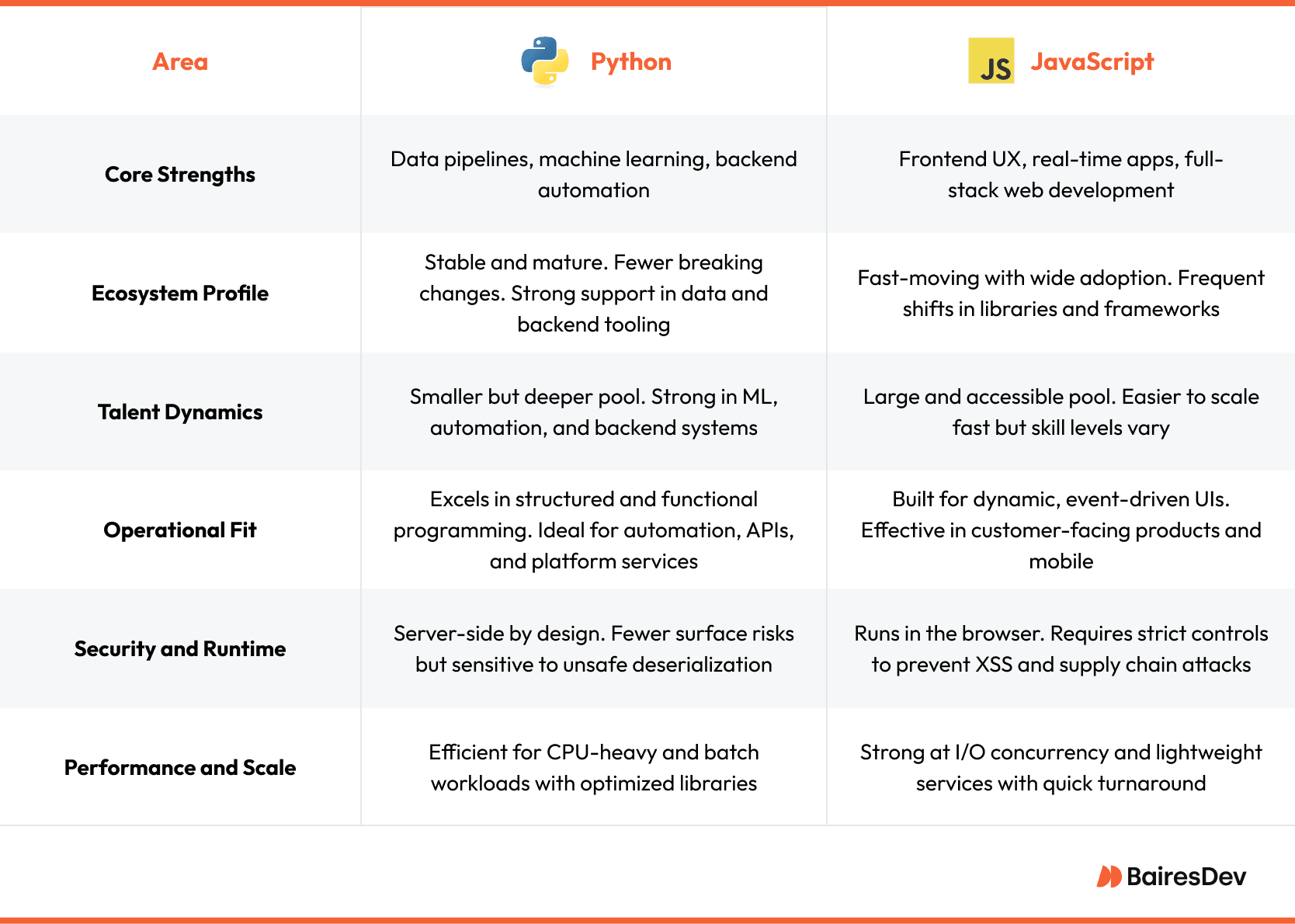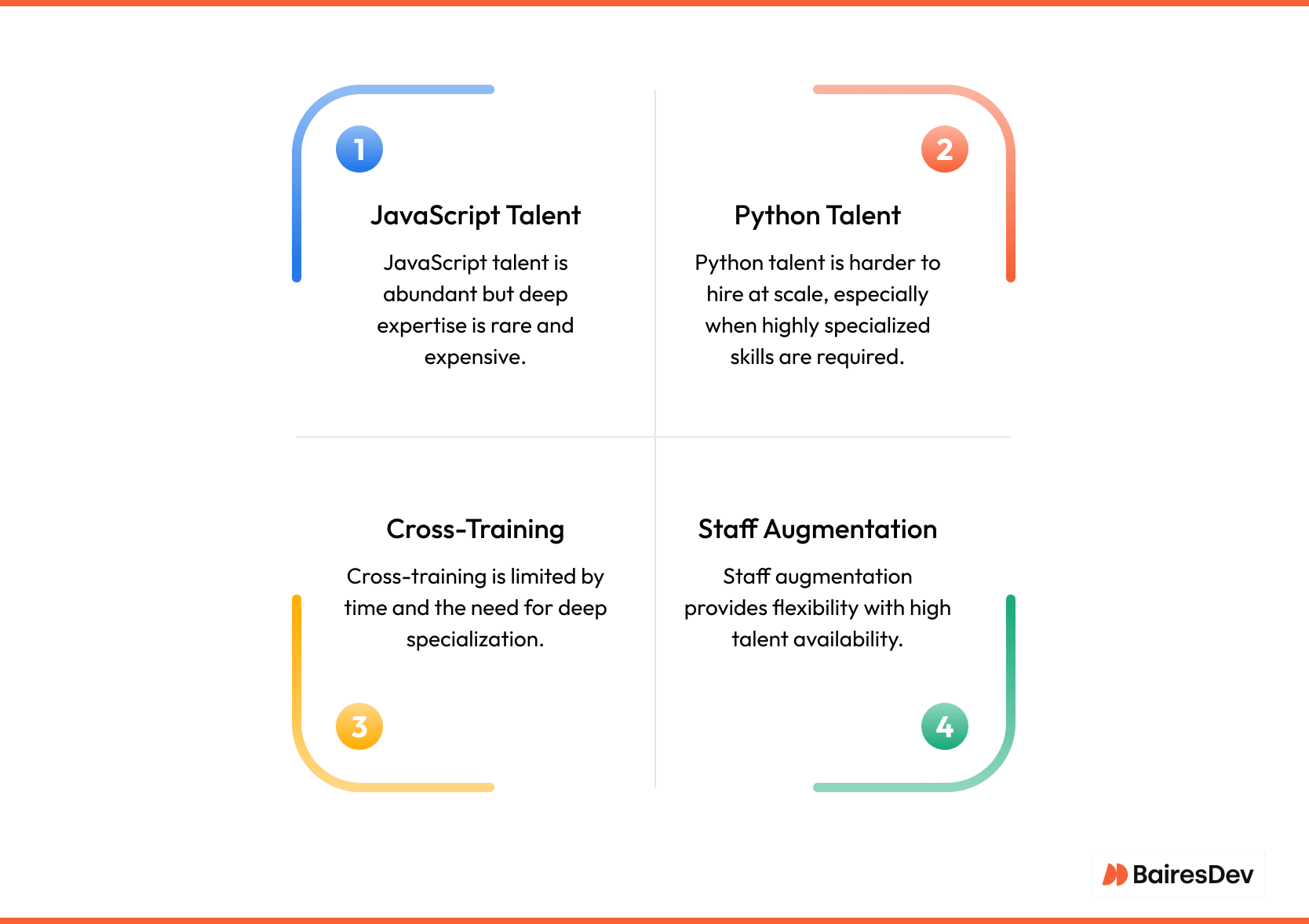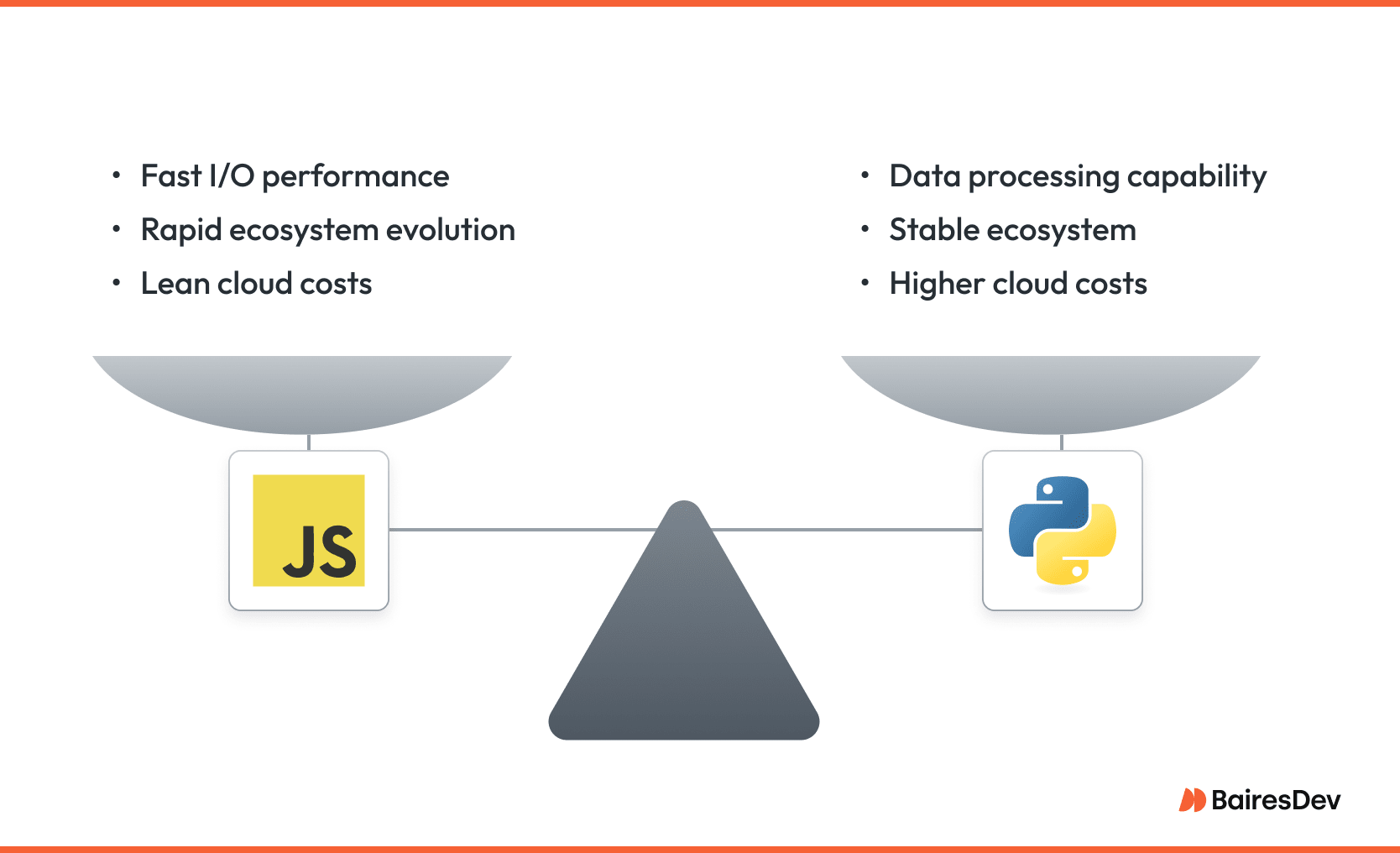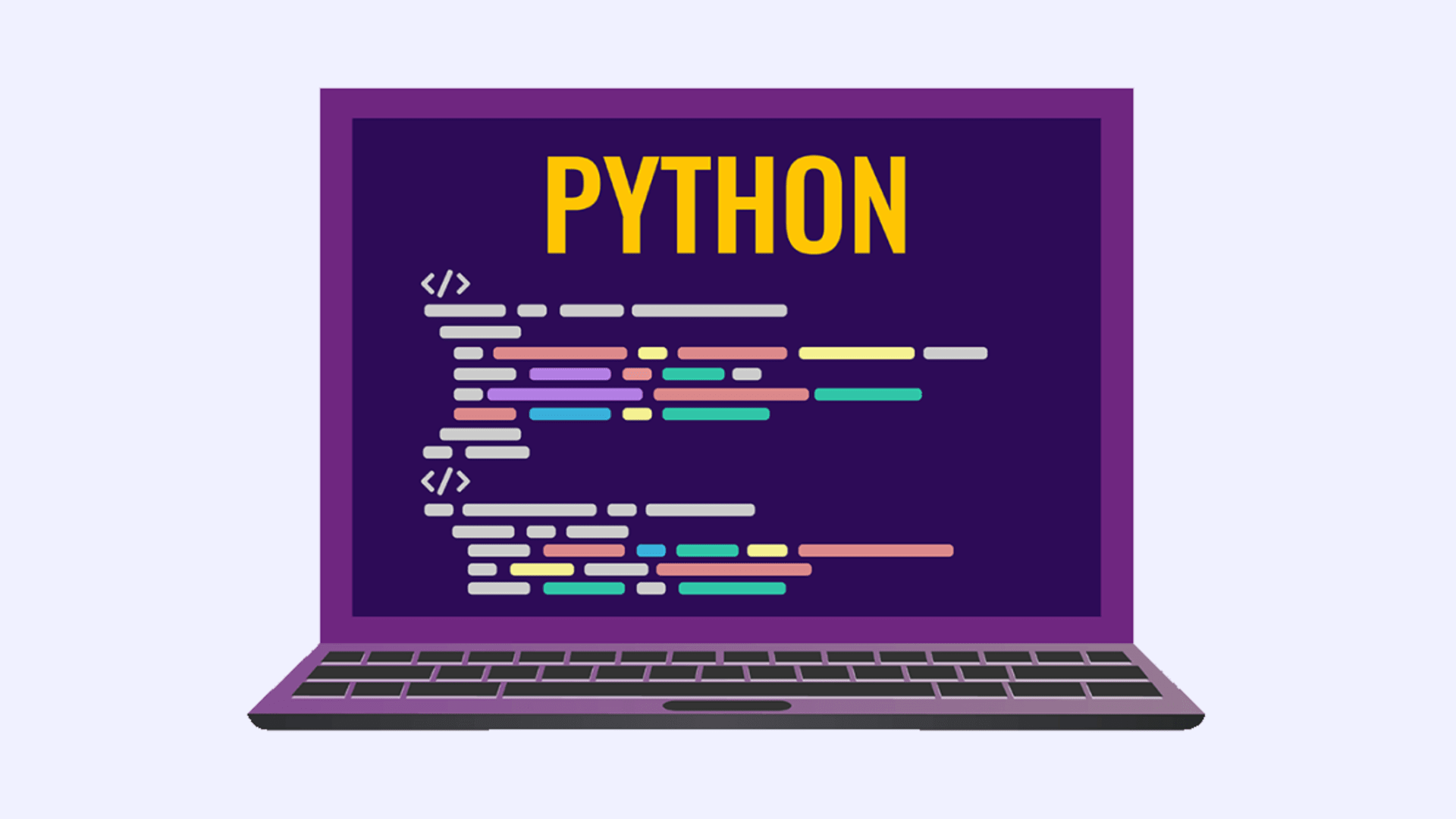JavaScript and Python have shared the developer spotlight for more than two decades, yet the choice between them remains a boardroom conversation as much as an engineering one. Market pressure for faster iteration, data-driven services, and polished digital experiences has compressed timelines and blended team boundaries.
This ongoing debate often overlaps with discussions around Python vs Ruby, as organizations evaluate which language best aligns with their architectural goals, hiring strategies, and development timelines.
A single language strategy looks appealing when you need to ship a minimum-viable release in a quarter. At the same time, the surge in machine-learning initiatives, process automation, and analytics workloads keeps Python at the center of many product roadmaps.
Programming language debates rarely hinge on syntax. They hinge on whether your architecture can tolerate risk, whether your hiring funnel can deliver senior talent quickly, and whether your operations team can keep services evergreen without heroic effort. Those concerns are magnified in 2025, when AI governance is tightening and customers expect feature updates in days, not months.
Understanding that JavaScript can be used for data science in this broader context is essential. It clarifies where consolidation saves money, where specialization unlocks velocity, and when a blended stack offers the safest path to scale.
Comparing the Roles: Where JavaScript and Python Actually Compete
Both Python and JavaScript rank among the most popular programming languages today, and for good reason. Each is an interpreted language with broad real-world adoption, but they approach problems differently. One leans into structured and functional programming, the other thrives in asynchronous, event-driven systems. This dynamic also plays a role in the ongoing discussion around whether JavaScript can be used for data science, as teams explore how each language fits emerging analytical and AI workloads. Their roles continue to evolve, and so does the space where they compete.

Shared Ground in Web Applications
Modern web development often pairs a JavaScript front end with a Python back end, yet the overlap is widening. React Server Components, Edge Functions, and increasingly capable Node.js runtimes let JavaScript teams render secure, interactive web pages without switching contexts.
Meanwhile, Python frameworks such as FastAPI match Node for latency on typical API workloads and come with first-class typing that satisfies security auditors. In customer-facing portals and dynamic web pages, the real contest is no longer which language can serve HTML faster, but which ecosystem delivers predictable throughput while keeping onboarding friction low—as seen in many famous apps built with JavaScript that dominate today’s digital landscape.
Diverging Strengths in ML, Automation, and Front-End UX
Artificial intelligence, machine-learning pipelines, data analysis, and scientific computing still favor Python. Its scientific libraries, type-hinting momentum, and rich model-ops tooling shorten the gap from prototype to production. It’s a true general purpose programming language.
JavaScript’s territory is different. Browser APIs, reactive component models, and a deep bench of UI packages let product teams craft interfaces that feel instant, adaptive, and reliable across devices. When latency budgets shrink to milliseconds at the edge, JavaScript’s event loop shines. When you must retrain a fraud-detection model overnight and redeploy without downtime, Python’s orchestration strengths win.
Language Interoperability in Modern Systems
Few organizations enjoy the luxury of choosing a single programming language. Cloud platforms expose polyglot runtimes, managed queues, and data services that speak both ecosystems fluently. Serverless functions in JavaScript code trigger batch jobs in Python code, and observability dashboards trace calls across both without special workarounds.
The question is not whether these popular programming languages can coexist, but how cleanly your architecture isolates responsibilities so that teams do not drown in context switching or duplicated tooling.
What Engineering Leaders Should Weigh Beyond Syntax
Before the debate drifts into tabs-versus-spaces territory, step back and look at what really keeps projects on track: the health of each ecosystem, how smoothly it plugs into your delivery pipeline, and the security baggage it drags along for the ride. The syntax wars ended years ago; what matters now is whether the runtime you choose will still be dependable when your roadmap, compliance team, and threat hunters all show up demanding answers at once.
Ecosystem Maturity and Stability
Python’s Package Index offers well-vetted scientific and data libraries that rarely break APIs, which is a comfort when regulatory deadlines demand reproducible results. JavaScript’s npm moves faster, sometimes recklessly, introducing major revisions of front-end frameworks every year. That velocity accelerates innovation, yet it also forces periodic audits to retire abandoned dependencies.
Mature governance mitigates both extremes: pinned versions and long-term support branches for critical Python workloads, automated dependency-update pipelines for JavaScript to avoid rot.
DevOps and CI/CD Toolchain Integration
When infrastructure engineers write code, Python dominates. Its readable syntax suits provisioning scripts, Ansible playbooks, and Lambda functions that stitch cloud services together. Continuous-integration platforms expose first-class Python executors for linting, static analysis, and security scanning.
JavaScript owns a different swath of the pipeline. Webpack, Vite, and pnpm drive asset compilation, while Node-based test runners push parallel suites that finish before the next commit lands. Effective organizations accept both rhythms: Python jobs secure the substrate, JavaScript tasks guarantee front-end fidelity.
Security Posture and Runtime Considerations
Client-side JavaScript inherits every browser vulnerability, from cross-site scripting to supply-chain tampering of minified bundles. Strict Content Security Policy rules, runtime integrity checks, and sub-resource integrity hashes reduce exposure, yet they demand discipline.
Python’s risks surface deeper in the stack. Unbounded input to pickle loaders or deserialization functions can open critical paths to remote code execution. Both Python and JavaScript therefore require a tailored threat model. Leaders must align static-analysis gates, dependency scanners, and incident-response playbooks with the realities of every runtime their teams operate.
Talent Strategy: Hiring, Scaling, and Specialization
Hiring decisions are rarely just about language or programming paradigm. They come down to availability, ramp-up speed, and the depth of experience candidates bring to real-world problems. JavaScript and Python each shape the talent equation in different ways, and those differences become critical when timelines tighten.

JavaScript Talent Pools and Front-End Culture
Ask any recruiter which résumés flood their inbox and you will hear the same answer: JavaScript, often wrapped in a shiny React or Angular badge. Software developer supply looks healthy on paper, yet skill depth varies. Some candidates know the DOM inside out, others have lived almost entirely in component libraries.
The gap matters when you need engineers who can diagnose hydration glitches in a server-side rendered storefront at three in the morning. Plenty of mid-level developers can ship UI tickets. Fewer can balance bundle size, accessibility, and observability without a senior looking over their shoulder. That rarity drives up rates at the top end of the pool, a reality worth baking into head-count forecasts.
Python Specialists and the Rise of ML Engineering
Python résumés look different. You see notebooks, data pipelines, Django back ends that power billing or authentication, and increasingly, production-ready machine-learning services. These software developers speak in model metrics and memory footprints. They track latency but focus on drift, versioning, and repeatable training runs.
Scarcity shows up when you search for people who can wrangle both TensorFlow graphs and Kubernetes manifests. Salaries climb fast for that well-rounded developers, yet retention tends to improve once they land, as few want to abandon their carefully tuned models for another green-field adventure every six months.
Cross-Training, Team Composition, and Delivery Models
Can a seasoned JavaScript developer pick up Python, or vice versa? Absolutely. The trick is timing. During a rapid-fire release cycle, forcing cross-training can drag velocity below the line leadership promised the board.
One pattern we see succeed pairs focused pods: UI specialists in JavaScript, service engineers in Python, each owning a crisp slice of the pipeline. Contracting or staff-augmenting works best when it plugs into that structure. Mix senior hands for architecture oversight with mid-level contributors who cover feature throughput. Institutional knowledge grows in layers, not leaps.
What It Means for Staff Augmentation
BairesDev keeps parallel benches for exactly this reason. Need six React vets to burn down a backlog? We have them. Want a trio of Python engineers steeped in MLOps to shepherd a recommendation engine from proof of concept to production? Same answer.
The talent equation is all about assembling teams that complement each other and unlocking roadmaps without waiting for rare hybrid unicorns to appear.
Performance, Scalability, and Operational Cost
Performance affects more than just response times. It shapes your cloud costs, your maintenance effort, and how well your systems scale under real-world load. Language choice is part of the equation, but architecture does the heavy lifting.

Runtime Performance and System Load Profiles
Put both languages under a profiler and you will notice divergent rhythms. JavaScript, running on V8, thrives when requests are short-lived and I/O heavy. The event loop keeps threads unblocked while calls fan out to databases or third-party APIs. CPU-bound math, however, can expose the limits of a single-threaded model.
Python battles the Global Interpreter Lock, which restricts true parallel execution in many cases. Yet in practice, data teams sidestep that ceiling with C-backed libraries such as NumPy, vectorized processing on GPUs, or multi-process workers behind a queue. Your architecture, not the language alone, dictates throughput.
Developer Velocity and Maintenance Burden
Speed is more than benchmarks. It is how quickly a production bug becomes a pull request and then a deployment. JavaScript projects live inside fast-moving ecosystems. Tools like Vite or Bun promise quicker builds, but each upgrade cycle invites breaking changes that chew up sprint capacity.
Python’s cadence feels calmer. Major versions land with long deprecation windows. That stability lets ops teams patch libraries without rewriting half the stack. On the flip side, Python packages sometimes lag in adopting new security primitives or performance-oriented syntax. Continuous-integration pipelines must compensate with static analysis, dependency pinning, and automated test gates.
Cloud Economics and Long-Term Cost
Instance pricing narrows when you abstract away the raw gigabytes and vCPUs. JavaScript workloads often run lean, especially when container images carry only the Node runtime and compiled assets. Python services ship heftier images packed with native dependencies and data libraries, which can lengthen cold starts in serverless environments.
Storage and egress charges climb for data-heavy workflows regardless of language, but Python’s prominence in analytics means those costs are more visible on the ledger. Savvy teams meter resource-intensive jobs, moving batch tasks to off-peak windows and scaling stateless APIs horizontally.
The Pragmatic Takeaway
Performance conversations rarely crown a single champion. They highlight trade-offs you accept or mitigate. Use Node for real-time chat, streaming dashboards, and edge-rendered pages. Reach for Python when model accuracy, data lineage, or complex business logic outrank sub-millisecond latency.
Above all, measure. Benchmarks written by someone else in a different cloud region will not protect your SLA. Instrument your code, capture P-percentile latencies, chart memory curves under load. Then invest where the graphs point, not where internet debates start.
Strategic Trade-offs: When to Lean Into One Stack or Blend Both
A single-language software development strategy looks elegant on a slide deck. Procurement loves the promise of fewer licenses, and onboarding feels easier when every repo shares the same linter.
That simplicity can pay off, especially if your product lives on a tight release cadence, your hiring funnel tilts heavily toward one talent pool, and your surface area is mostly web and mobile. A Node-only stack running React on the edge and Express in the core can move fast, iterate daily, and keep cognitive load manageable for a lean team.
Yet specialization wears a different crown. The moment you introduce data-science roadmaps, event-driven analytics, or automate tasks, Python’s ecosystem earns its keep. Trying to coerce JavaScript into that role means stitching together niche libraries or off-loading heavy computation to separate services anyway. At that point, “one language” becomes “one language plus a growing list of work-arounds, involving other programming languages”
Blended stacks succeed when the architectural seams are deliberate. Keep JavaScript where user experience lives: front-end web development, anything that touches the web browser first. Let Python own the data and machine-learning lanes, where reproducibility, numerical libraries, and mature MLOps tooling matter more than raw request latency. Container boundaries, message queues, and clear API contracts turn language diversity from liability into insurance. If one runtime falters under load, the other keeps the lights on.
Ultimately, the choice is less about code and more about operational discipline. A unified stack buys short-term clarity; a polyglot stack buys long-term resilience. The right answer rests on roadmap volatility, compliance overhead, and how much trust you place in automated deployment pipelines.
Final Take: Choose the Language That Serves Your Architecture, Not Trends
Python and JavaScript both have extensive ecosystems. Neither is fading, and both will continue to cross-pollinate. For engineering leaders, the winning move is to map language capabilities to business outcomes, then staff accordingly.
If customer-facing speed defines success, lean harder into JavaScript—with support from specialized JavaScript development services to maximize impact. If insight and automation drive competitive advantage, partnering with expert Python development services can help unlock the full potential of Python’s ecosystem. Most organizations land somewhere in between, running each language where it shines and trimming overlap with strong DevOps hygiene. The stack that fits your architecture will outlive whichever language the hype cycle crowns next. To fully leverage Python’s strengths and scale your initiatives effectively, make sure to hire top Python developers who can bring expertise and strategic execution to your projects.
Frequently Asked Questions
What metrics should guide our language choice at the portfolio level?
Focus on deployment frequency, mean time to recovery, and feature lead time. If a language’s tooling accelerates those numbers without inflating incident count or cloud spend, it is serving the business.
How do we avoid talent bottlenecks after consolidating around one language?
Pair senior engineers who already own core modules with upskilling programs that rotate mid-level staff through stretch tasks. Monitor cycle time during the transition; if velocity dips for more than two sprints, consider bringing in staff-augmentation specialists to backfill.
Common pitfalls when consolidating on a single language
Teams often underestimate legacy rewrite effort, overlook edge cases that rely on language-specific libraries, and assume performance parity across runtimes. Mitigate by auditing dependencies, benchmarking critical paths, and budgeting time for unexpected refactors.
How do long-term operating costs differ between Python and JavaScript services?
JavaScript workloads tend to consume fewer resources per container but can multiply quickly due to smaller micro-services. Python services may run heavier per instance, especially with data libraries, yet often consolidate more functionality into a single process. Cost neutrality depends on right-sizing and autoscaling policies rather than language alone.
When is it worth introducing a second language into a mature, single-stack platform?
Introduce another language when clear feature demands, such as advanced analytics or real-time collaborative editing, require libraries or runtimes your current stack cannot match without excessive engineering effort. The tipping point is usually when workaround complexity begins to erode release confidence.
Are there heightened security considerations when operating a polyglot environment?
Yes, every runtime adds its own dependency graph and vulnerability surface. Maintain separate SBOMs, run language-specific static analysis in CI, and align incident-response playbooks with each ecosystem’s patch cadence. Security posture improves when boundaries are explicit and scanning is automated for every build.






